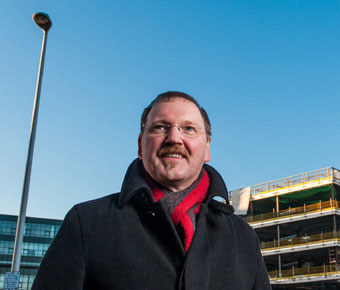
05 Apr 2016
The University of Glasgow’s plans for a £1bn extension of the Gilmorehill campus take another step forward this month with the handing over of the former Western Infirmary site.
The majority of the extension will be on that site - a rare opportunity to develop 15 acres of land right next to the University, in the heart of the West End.
It’s worth pausing for a moment and considering the sheer scale of the investment involved. The £1bn investment – which brings together a combination of existing financial resources and an ambitious fundraising campaign - represents the equivalent of twice the budget for Glasgow’s Commonwealth Games.
It’s also bigger than the budget for the new Queen Elizabeth Hospital, which already has a strong University presence. In fact I am struggling to think of a bigger development project in Scotland once the Queensferry Crossing of the Forth is finished.
What is especially impressive is the ambition the University has to create what is effectively a new district in the West End, accessible to the public whilst at the same time providing a new home for multi-disciplinary research and a model of future centres for student learning. That the development will be fully delivered only five years from now is equally gob-smacking.
I sat next to business angel Sandy Black at the Chancellor’s Dinner recently, hearing more about his role in chairing the fundraising committee to lead the largest philanthropic campaign in the University’s history, and during the evening, Principal Professor Anton Muscatelli presented a short video summarising some of the University’s most notable research successes of the last year.
I’ve always recognised how difficult it is for the major universities to communicate the importance of the work they do, since most lay people need help understanding the context. This year the University has been making a determined effort to provide that help. So from the video we hear from four of its senior academics explaining their work.
I’ve written before about the leading role Glasgow has in precision medicine, and Professor Anna Dominiczak, Vice Principal and Head of the College of Medical, Veterinary and Life Sciences, has taken part in several Chamber events to help us understand why that is the case. This is where the work of the Queen Elizabeth Hospital is so important. Related to that work, Professor Andrew Biankin also explains the breakthroughs the University is making in tackling pancreatic cancer.
In one of the most high profile scientific discoveries of the year, Professor Sheila Rowan describes how the University made a significant contribution to the confirmation that Einstein’s predictions of gravitational waves were correct.
The final contribution is from Professor Lee Cronin, Regius Professor of Chemistry, under the headline that Glasgow is planning to do for prescription drugs what Google has done for the internet. His research team is called the Cronin Group.
Here I’m quoting straight from the Cronin Group’s own publication: ‘In the future, it might be possible to develop an application for a robot to create a molecule and do design according to a specification. Once a discovery is made, the coordinates of the new molecule in the chemical space could be stored as a code, making reproducibility cheap and easy, and hence changing the manufacturing process as we know it. The code could be used again and again. The potential of this system in the pharmaceutical industry is massive’. Now I’m not even going to pretend that I understand what this means so it’s better you hear from Lee Cronin himself.
In Professor Cronin’s work you get a much better understanding of what multi-disciplinary research means and why the development of the new campus makes such a feature of that in the planning. If one day you plan to print molecules using 3D printers then bringing computer science, physics and electrical engineering together with chemistry makes all the difference.
Of course there is considerably more work going on inside the University that could have been highlighted in the video; in quantum and nano technology, in the fight against the Zika virus or in the Urban Big Data Centre for designing future cities, some of which we have explored at the Chamber.
The message though is perfectly clear. The University of Glasgow is on the cusp of big change, and that change promises a dramatic boost to the success of our city and our business community. It’s time to pay attention.